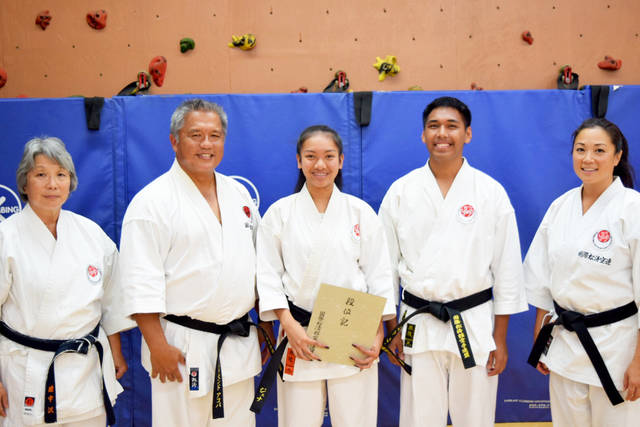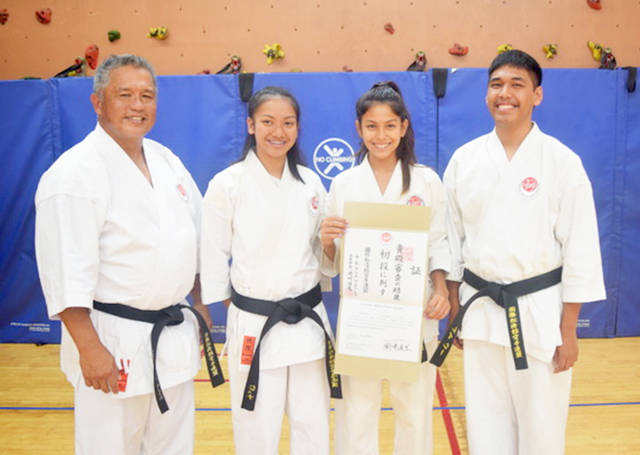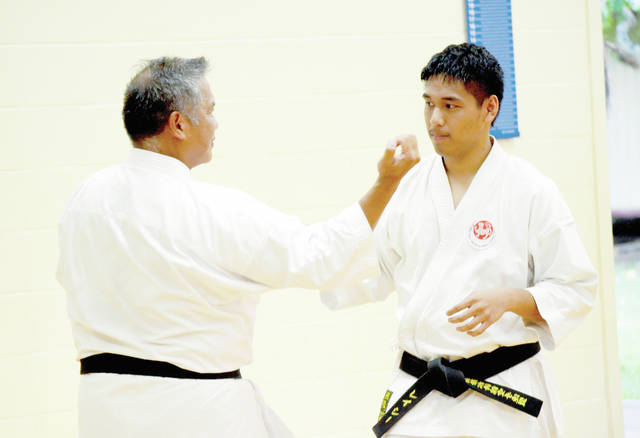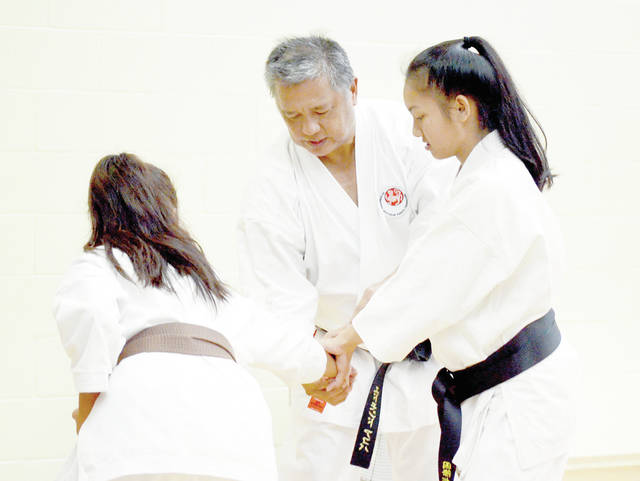Talk Story: Edmund Acoba

Photo courtesy Edmund Acoba
From left, Lynette Nakazawa, Edmund Acoba, Jenna Galiza, Rey Agcaoili and Amber Strong stop for a photo at the Weinberg Gym at Island School in Puhi earlier this year. Galiza, a sophomore at Kauai High School, was promoted to the rank of shodan (first-degree black belt) by the International Shotokan Karate Federation.

Photo courtesy Edmund Acoba
From left, Edmund Acoba, Jenna Galiza, Kilinoe Brown and Rey Agcaoili stop for a photo at the Wilcox Gymnasium at Island School in Puhi. Brown recently was promoted to shodan, or first-degree black belt.

Nick Celario / The Garden Island
Sensei Edmund Acoba, left, demonstrates as student Rey C. Agcaoili follows during a karate class at Island School in Puhi.


Nick Celario / The Garden Island
Sensei Edmund Acoba, left, instructs as student Jordyn Estenzo-Fernandez follows during a karate class in late October at Island School in Puhi.
Sometimes, seeing your pupils reach new heights can be the gift that keeps on giving.
Sometimes, seeing your pupils reach new heights can be the gift that keeps on giving.
For local karate sensei Edmund Acoba, that is why he does what he does.
“The ones that have been with me, especially the higher ranks, they’ve been there for quite some time now — some of them since the inception of the school in 2010. Most of the students, they’ve been promoted to black belt the last two to three years. They’ve been with me six, seven years. There’s a core of them,” Acoba said.
Twice a week, he holds karate classes at Island School in Puhi.
Acoba is also a state judge at the Lihue courthouse and a Waimea High School alumnus.
He sat down with The Garden Island and talked about how he started learning, flying to the mainland to earn his black belt, becoming an instructor and some of his experiences mentoring local youth through martial arts.
You’re also a judge. How long have you been doing that?
Seven years. I was a public defender for 23 years an also a prosecutor for about a year and 10 months.
Just curious, why law?
I went to the University of Hawaii. I was in business school. I wanted something more than just coming out with a bachelor’s. I was looking at the MBA program or law. I got into law.
I got inspired by a cousin that was practicing law. I had a friend that was in law school. So I decided to try it out. I just stuck to it. I was fortunate. In 1997, after I graduated law school, I was offered a position on Kauai. So, I came back.
So how did you get into karate?
I got involved in martial arts when I was around 9 years old. Francis Hosaka was my first instructor. He taught kajukenbo out on the Westside of Kauai. I trained with him for a while until I got really involved with other sports, then I kind of got away from that.
I picked it up again when I was in college. At the University of Hawaii, I trained under Tago Mori. He was with the Japanese Karate Association. He was offering a class at the college. … That kind of revived my interest in martial arts again. Then, I started (taking classes) outside of the university with Ed Luis from Foster Village. His style was kenpo karate. I trained with him for a while until I graduated college and went to law school.
Picked it up again when I came back (to Kauai) about 2005. I started training again with Kamal Salibi. He was the sensei at Kauai Athletic Club. … I started training. Like, “Oh, maybe I’ll get back into it.” I got into it.
At that time, there was a split going on with shotokan karate. In Hawaii, there was Shotokan Karate International Federation. They were forming their own (group). They were splitting away from Japanese Karate Association. And then, they had the International Shotokan Karate Federation. They were splitting, so I had to pick. Although I was training with both sides, I had to settle into one club. So, I went to ISKF. That was started by Tram Meadows. We were training out in Koloa.
In 2010, I attended a master camp so I could test for my first-degree black belt. I flew to Pennsylvania. (I tested) in front of the masters. I had the top level of the organization there. I wanted to be legit, that my level of training met their expectation of what you should be when you become a black belt. It was important for me to be not in front of my own sensei, but in front of them to make sure that I’m up to their standards.
Sounds like a pretty big accomplishment.
It was. I’ll set the scene for you. There was a special building that they hold the test in. On the front panel, they had all the highest- ranking black belts including the master. His name is Teruyuki Okasaki. He was a 10th-degree black belt. He was the highest ranking in the organization. The ninth-degree black belt, he was there. All of the technical committee who standardized all the movements and stuff, they were all there. (Along the) walls, they had black belts from a lot of the organizations throughout the world, and they had some people that were training to be instructors. They were all lined up. It was a pressure situation.
Then, they had people surrounding the building. They didn’t want other people to come in and see what was going on because they didn’t want them to go back later and say, “OK, this is what they’re going to do. Let’s just train for this.” I went in there prepped as much as I could be prepped. Then, they administered the test.
Part of the training was that I had to show I am able to protect myself. They put someone in front of me, and we had to actually engage in a sparring match. So, I faced off against this guy from Brazil. Not knowing how he fights, I had to show that I could protect myself and that I wouldn’t get injured. And if I should counter, I was able to control my technique so he wouldn’t get injured.
It was brutal, the test. By the end of the test, I was spent. Everything was left on the floor, and I did my best. The next day, they came back with the results. I was fortunate that I received my black belt.
What’s your current rank?
I’m a second-degree black belt right now. It took me a while. I didn’t go to camp or anything like that. It was about two years ago.
Why do you like it?
One, I like the training. Two, I want to be able to be confident out there as far as if something should happen to me, I can at least get out of a situation. We don’t train to get in the ring and fight. That’s not the purpose of our training.
We go through this anti-bullying thing, but what I always emphasize is, I talk about the law because it’s my area of expertise. I tell my kids to remember that we can only use reasonable force. That doesn’t mean that we get all this training, and then we can go beat somebody up. Even if they’re causing harm, you can’t just go beat them up. What you got to do is use enough force to get out of the situation. It’s not standing there and beating them until they’re unconscious. That’s not what it means.
I don’t know if you can talk about this, but because you’re a judge, have you been in situations where you had to defend yourself?
Well, in my job, when I’m out in the public, I don’t have the sheriffs surrounding me. I’m vulnerable. If someone doesn’t like my decision, they could easily just come up to me and do something. I just want to be able to get out of a situation.
No, it hasn’t happened. Knock on wood. And, that’s why I had to limit my activities, too. I used to like to ride bikes and stuff. But my wife told me, “What if you’re out riding your bike and somebody sees you? If they don’t like your decision. They can just hit you and just leave, you know?” Then, I’m thinking, “Yeah, you’re right.” But fortunately, I haven’t had that encounter yet.
How did you get into teaching karate?
What was happening to our school at the time, our sensei Tram Meadows moved to Florida. Our school already was falling apart because our sensei was gone. Jan TenBruggencate and I were really the only two members that really wanted to train. He’s older. I approached him. I asked, “Jan, do you think I could start a school in the Lihue area?” He said, “Yeah, sure. Go ahead.”
Mike Goto, who’s the financial director at Island School, he was training in shotokan karate. I asked, “Hey, Mike. Is there space at Island School that we could use to start a dojo?” He was so open to that. I said, “Then, students at Island School can come and train also after school.” He was so open. That’s how we started at that gym.
It’s not just for Island School kids, is it?
No. It’s open. He was nice enough to say we can open it up. We put an ad in The Garden Island saying I was starting this school.
How many students do you have?
Right now, if they all came back to train, I would have about 15. We try to keep it small. Small space. Plus, it’s only me. Jan is semi-retired or retired. So, it’s just me running the school.
(The number of students attending classes), it fluctuates. But during summer time, we have a lot of students. And then, we have visitors that come. We’ve had visiting instructors.
What can you say about some of your experiences teaching and mentoring?
What I really like about working with these kids, for example we talked about Kilinoe Brown, who was recently promoted (to black belt). She’s from Moloaa. Her parents would drive her from Kilauea School to Lihue in the traffic. She would attend almost every class. Sometimes, I understand, she would even catch the bus just to make it to class. What it tell me is that this girl, she really put her mind to what she wanted to do. She earned her black belt. It’s not like she was sporadic in her training. She was consistent, and she showed the desire to want to excel in something.
From my experience with her, it really spoke a lot to me. That’s what I hope to instill in all the students. I got three who are now in college. I have three more excelling in school. … That’s what I hope to instill in them. That if you put your mind into things, commit yourself — which are all principles that we teach at the school — you can succeed in life.
When you see your students excel, whether through karate class, school, etc., how do you feel about that?
Those are proud moments because you had a hand in doing something, in bringing them to accomplish something they wanted to accomplish. To me, it’s a very proud moment. What it shows me, again, their desire to accomplish something and they’ve reached it. It’s not the ultimate. The ultimate is that they can go more. I keep telling them, “You got to be a student in life.” Every day is a new experience. You got to learn from whatever you’re faced with. That’s what I try to instill in them, that you got to be lifelong learners.
How much do classes cost?
$15 a month.
That’s it?
That’s it. We’re not in it for the money. That covers our insurance. I use it to buy certificates for the kids when they get promoted. But it means we need to save our money because we need somebody to come here. Like I said, I want them to have another set of eyes on them to say, “OK, you’re at that level. You can be promoted to black belt.” For example, in July it cost us almost $2,000 to bring this sensei from Washington in to test them. So basically, we try to save our money so that when the time comes, we have enough money to bring a sensei in.
A lot of times, I pay for the belts when they promoted. It’s my way of rewarding them. I pay for that. When they got their black belts, it’s my thank you to them because they dedicated their time to getting to that level. I buy custom black belts. It has our organization name on the left side, International Shotokan Karate Federation, and whatever name they want on the other side. First name, last name, you tell me what and I put it on. One of those belts costs about 75 bucks.
•••
Nick Celario, sports writer, can be reached at 245-0437 or ncelario@thegardenisland.com.


